Reviews
Jerzy Skolimowski
UK, 1978
Credits
Review by Anna Bak-Kvapil
Posted on 22 June 2011
Source 35mm print courtesy of Park Circus/London
Categories Jerzy Skolimowski: Eros & Exile
“Nauseating” may be the best way to describe the sound of Alan Bates screaming in The Shout. Bates plays Charles Crossley, a maniac who, after 18 years of living in the Australian Outback, has mastered a “terror shout” technique from an Aboriginal shaman, and can now kill anyone in hearing distance with sound waves alone. His shout sounds like a combination of a thousand nails dragged across the brittlest chalkboard, the highest pitch of a fire alarm, and a train putting on very rusty breaks, creating a visceral, near-primal reaction in the listener. Through what is rumored to be 40 tracks of Dolby, the sound was created without special effects, and precedes by 15 years the similar, although significantly less upsetting sound of the T. Rex roaring in Jurassic Park.
Despite having won the Grand Jury Prize at Cannes, Vincent Canby’s 1978 New York Times review called The Shout a “piercingly loud movie as well as an almost totally incoherent one.” His review illuminates facts included in the press notes but never revealed in the film: a young Tim Curry, who listens to the story Charles Crossley tells him, is meant to be playing Robert Graves, author of the story the film is based on. And apparently, people do exist who are able to produce sounds louder than a jet engine. None of these details are important, however, because The Shout is meant to be a sensory experience rather than a classically narrative one. Part fairy tale, part Twilight Zone episode, part psychodrama, part experimental film, The Shout throws all Skolimowski’s favorite themes up into the air and lets them rain down like confetti.
At a cricket match held at a bucolic mental asylum, Robert Graves, a visiting observer, falls into conversation with Crossley, who appears to be an inmate. Crossley starts a story, saying, “Every word of what I’m going to tell you is true. And yet I’m telling it in a different way. It’s always the same story, but I change the sequence of events and I vary the climaxes a little because I like to keep it alive.” Skolimowski prepares his audience for incoherence, although the tale, concerning the appearance of Crossley at the table of happily married couple Anthony and Rachel Fielding (played by John Hurt and Susannah York, respectively), who live in a usually quiet village, initially appears simple.
The Shout was filmed on location in North Devon, the picturesque coast of England where green valleys give way to dramatic seaside cliffs and sand dunes. But the British countryside, so often portrayed as charming and romantic, is menacing and hollow here, a series of empty landscapes where rogues like Crossley wander freely in and out of the dwellings of helpless townsfolk. All of Skolimowski’s films concern some aspect of alienation, but this film inverts his typical stance slightly; a settled couple is afraid of a stranger, and their home is made strange around them by his presence.
While Skolimowski uses exaggerated sound as an essential component of all his work, in The Shout he is entirely obsessed with the aural environment. Ambient electronic groans and whispers, and an amplified babble of daily life - sheep bleating, metronomes clicking, wind blowing - invades every moment. In a scene where a character chops wood, not only does the axe make a thunderous noise, but a bicycle falls over with a metallic clank, a block of wood shatters a window, and a dog starts barking. Anthony Fielding communicates through sound almost as much as Crossley does; as an experimental sound artist, he tapes marbles rolling around on metal and bees trapped in jars, while making his living more legitimately as a church organist. The ability of sound to sicken and discomfit, to produce anxiety and fear, is explored not only through the powers of the terror shout, but also through the ugly sounds that Fielding creates in his recording studio, as he runs a violin bow discordantly over jagged metal or screams into his microphone in weak imitation of Crossley.
When Crossley first invites himself to lunch at the Fielding’s tidy white cottage, he hints at his supernatural control over sound by drawing his wet finger along the rim of a wine flute at such a high-pitched frequency that it shatters a nearby glass. Crossley, who crushes wasps with his bare hands and considers anecdotes about killing his children to be appropriate casual conversation, is insane in the most charismatic way. Alan Bates, who always has a manic gleam in his eyes and a sense of easily offended vanity, is ideal as a preening, unstable, but hypnotic mad man. His magic abilities may not be magical at all—he may simply be gifted with an ability to persuade others of his powers. As he tells Fielding, “If a man is convinced he’s going to die, he simply slips away and dies.”
Appropriately, the centerpiece of the film is the materialization of the shout, the point at which the story shifts, briefly, out of the hypothetical and into violent actuality. The scene begins, heavy with tension, as Fielding and Crossley walk on sand dunes under a gloomy sky, scored by electronic, low-register tonal shifts. Before Crossley screams, the camera catches him from an extremely low angle, as he bends forward in his heavy black overcoat, then so far back his head disappears. When he shouts, an extreme closeup of his open mouth reveals the aggressive and barbaric-looking gold fillings of his back teeth. A herd of sheep and their herder fall over dead, Fielding passes out, and Crossley wanders to the edge of the ocean, absently picking up a dead gull by the wing.
Following the shout, the film dissolves into a jumble of plotlines and images that only flirt with congruity. The motivation behind Crossley’s destruction of the Fielding’s lives is unfathomable, but he is preoccupied with the human soul, and, in “moments of spiritual starvation, ” has stored parts of his own spirit in trees and stones, fragments of which Fielding locates through cryptic, visionary methods. Spells are cast with bones, stones, buckles, and shoes, and The Shout becomes a delirious, ambiguous collage of impressions and abstract events. With a resolution deliberately left open to interpretation, the last sound heard in the final scene is only the doleful, impotent rumble of receding thunder.
More Jerzy Skolimowski: Eros & Exile
-
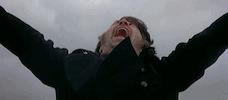
The Shout
1978 -
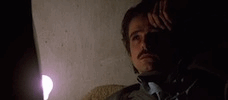
Moonlighting
1982 -
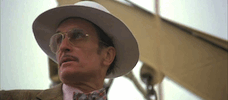
The Lightship
1985 -
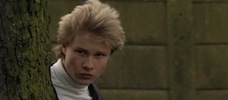
Success Is the Best Revenge
1984 -
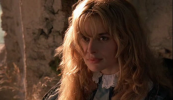
Torrents of Spring
1989 -
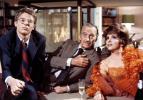
King, Queen, Knave
1972
We don’t do comments anymore, but you may contact us here or find us on Twitter or Facebook.



